
 Baker Hughes has been awarded a multi-year contract from ExxonMobil Guyana to provide specialty chemicals and related services for its Uaru and Whiptail offshore greenfield developments in Guyana’s Stabroek Block, one of the most prolific oil discoveries of recent years.
Baker Hughes has been awarded a multi-year contract from ExxonMobil Guyana to provide specialty chemicals and related services for its Uaru and Whiptail offshore greenfield developments in Guyana’s Stabroek Block, one of the most prolific oil discoveries of recent years.
The contract includes all topsides, subsea, water injection and utility chemicals for the Errea Wittu and Jaguar FPSO vessels, which are currently under development, and are targeted to begin production in 2026 and 2027 respectively. Baker Hughes has established local supply chains to create a reliable and efficient source of chemicals to address the unique needs of these developments.
Uaru and Whiptail are ExxonMobil Guyana’s fifth and sixth projects in the country, where it has been producing oil for more than five years. The two developments will include up to 20 drill centres and 92 production and injection wells. Each FPSO will have a capacity of 250,000 barrels per day, bringing the country’s total daily production capacity to approximately 1.3mn bbl. According to its recently-released 2024 results, Exxon Mobil achieved record production in Guyana last year.
Since “first oil” at the offshore Liza Phase 1 project five years ago, Guyana is now the third largest per capital oil producer in the world and is seeing its offshore sector expand rapidly, which in turn is spurring significant economic growth in the country.
Baker Hughes has a strong history of localisation in Guyana, opening a multimodal supercenter in Georgetown in 2022. The company also provides a variety of services and equipment to operators in the country, including turbomachinery for ExxonMobil Guyana’s FPSO fleet and production chemicals for the Liza Unity vessel.
“ExxonMobil Guyana and Baker Hughes share a long history of supporting Guyana’s energy sector, and we look forward to working together to write its next chapter,” said Amerino Gatti, Executive Vice President, Oilfield Services & Equipment at Baker Hughes. “Our experience operating across the country’s energy supply chain and unmatched expertise in oilfield and industrial chemicals make Baker Hughes uniquely suited to support complex FPSO operations such as these.”

 Halliburton has finalised its acquisition of Optime Subsea, resulting in American giant now owning 100% of the Norwegian company.
Halliburton has finalised its acquisition of Optime Subsea, resulting in American giant now owning 100% of the Norwegian company.
Jan-Fredrik Carlsen, CEO of Optime Subsea, said, “Joining Halliburton is a proud moment for Optime Subsea. This acquisition will allow us to scale our innovative technologies, reach new markets, and continue delivering exceptional value to our customers worldwide.”
Since its founding a decade ago in 2015, Optime Subsea has committed to delivering cost-effective subsea solutions to the oil and gas industry, including its flagship technologies Subsea Controls and Intervention Light System (SCILS), and the Remote Operated Controls System (ROCS).
With Halliburton’s global reach and extensive infrastructure, Optime Subsea is now positioned to accelerate deployment of its technology on a larger scale to provide a more robust portfolio of subsea control and intervention solutions.
“As we transition into this exciting new chapter, our commitment to innovation, customer satisfaction, and operational excellence remains unwavering. As part of Halliburton, we look forward to creating new opportunities and delivering unmatched solutions to the energy sector,” commented Carlsen.
The acquisition represents a shared vision between Optime and Halliburton to drive progress and efficiency in subsea operations. The two aim to redefine standards for reliability, sustainability and performance in the subsea industry.

 Well-Safe Solutions has received a further contract extension from Eni Energy Netherlands BV to decommission selected subsea and platform wells across the Italian energy giant’s portfolio in the North Sea.
Well-Safe Solutions has received a further contract extension from Eni Energy Netherlands BV to decommission selected subsea and platform wells across the Italian energy giant’s portfolio in the North Sea.
Eni have exercised another 90-day option for the Well-Safe Protector jack-up asset under the new contract. The work will be executed in direct continuation with the previously declared option which commenced in November 2024.
Upon the completion of the latest option for Eni, the Well-Safe Protector will move onto the Spirit Energy contract which was announced in November. By completing the work for multiple operators, Well-Safe Protector will be committed until at least August 2025, with further long-term options agreed with Eni.
The new amendment offers increased flexibility for Eni which has the option to green light an additional 120 days of work to decommission platform wells immediately after the completion of work for Spirit Energy, along with two further options at 180 days each. If these options are exercised, Well-Safe Protector has the potential to remain outside the UKCS until Q4 2026.
Well-Safe Protector has been operational in the North Sea since August 2023, having already decommissioned 25 wells across the Dutch and UK waters for Eni, Ithaca Energy and Neptune Energy.
Phil Milton, Chief Executive Officer at Well-Safe Solutions, said, “Well decommissioning continues to account for a considerable amount of the North Sea’s overall decommissioning activity – with a 50% increase in well decommissioning forecast by OEUK last year.
“Since the Well-Safe Protector first mobilised in August 2023, it has delivered top-quartile operational uptime – ensuring the learnings from continual well decommissioning activity are reinvested into future work scopes. Effective well decommissioning cannot exist without cooperation, and we are looking forward to deepening the partnership we currently enjoy with Eni as we build the foundations of a long-term well decommissioning campaign at this key moment in the North Sea’s development towards a low-carbon future.”
This latest contract continues a period of growth for the business. In November 2024, the company announced two new contracts totalling US$25mn for approximately 170 days of firm work in the North Sea, using Well-Safe Protector and the Well-Safe Defender semi-submersible, for Spirit Energy and an additional global operator.

 Identifying the urgency of adequate support for North Sea operators, Houston-based offshore innovator, Trendsetter Vulcan Offshore, has appointed Finlay Johnston to lead business development efforts for the company in the United Kingdom.
Identifying the urgency of adequate support for North Sea operators, Houston-based offshore innovator, Trendsetter Vulcan Offshore, has appointed Finlay Johnston to lead business development efforts for the company in the United Kingdom.
“There is a long-term need for expert subsea support services in the UK, and by engaging a local representative, we are strengthening our commitment to the region, providing an avenue for North Sea operators to access our proven solutions, and ensuring the supply of quality service and equipment locally,” said TVO President Jim Maher.
Onboarded via 4C Global Consultancy, where he is a Senior Executive, Johnston will be spearheading TVOs services in the UK region, equipped with a vast range of experiences from commercialising assets to supporting the growth of drilling contractors, well intervention, well abandonment, marine and multi-service companies.
TVO is banking on the reputation of 4C Global Consultancy and Johnston's extensive experience to serve its clients in the UK. "The consultancy has a history of successes that demonstrate their capability, and Finlay’s personal achievements strengthen the value of this partnership,” said TVO Vice President Kevin Chell.
As a local representative, Johnston will supervise TVO's activities in line with Norwegian Shelf Competitive Position (NORSOK) standards and the regulatory requirements of the North Sea Transition Authority (NSTA) to implement the company's expert services such as wellhead cyclic stress reduction, among other offerings. The wellhead is exposed to extreme pressure conditions when massive structures initiate the process of oil & gas extraction. Addressing stress reduction through structural integrity and reliability thus holds immense significance to make the exploration and production process a success.
TVOs other services are aligned with the ambitious targets of conducting the plugging and abandonment (P&A) of more than 200 wells in a year, designed to address the challenges involved.
The North Sea oil & gas scene has witnessed an especially turbulent period since the announcement of the energy profits levy (EPL) in 2022 as a temporary arrangement, but it never went away, with the tax margin seeing a consistent rise with time. To top that, the energy generator levy was announced as well. Under such volatile economic circumstances, TVO's local presence will bring certain relief to regional operators by making its critical technology easily available.
“We ... are continuing to add to our global team,” said Maher on the onboarding of Johnston, which follows the recent appointment of a Country Manager in Australia.
As a commercial leader with more than 25 years of international experience in business development, contracting, and customer relationship management in the energy sector and finance, Johnston has worked with corporate leaders and the C-suite of S&P 500 companies.
“By enhancing the company’s commitment to the region with boots on the ground and aligning with well teams, decommissioning and well management companies, TVO will be able to improve project efficiency with proven solutions that reduce cost and risk for operators in an environmentally sensitive area," he said.
To know more about the well intervention scene in and around the European Union regions, click here.

 Baker Hughes has reached an agreement with the Nigerian National Petroleum Corporation (NNPC) and FIRST Exploration & Petroleum Development Company (FIRST E&P) joint venture (JV) to deploy its Leucipa automated field production solution on the JV’s offshore operations in the Niger Delta.
Baker Hughes has reached an agreement with the Nigerian National Petroleum Corporation (NNPC) and FIRST Exploration & Petroleum Development Company (FIRST E&P) joint venture (JV) to deploy its Leucipa automated field production solution on the JV’s offshore operations in the Niger Delta.
The deployment marks the inaugural adoption of the system in Sub-Saharan Africa. The JV will utilise Leucipa’s core workflows to optimise well performance and enhance efficiency by automating functions including performance analysis, opportunity management and scorecards management.
Real-time data will be provided by the technology which will offer more insightful optimisation opportunities across operations, resulting in enhanced decision-making in the field.
Amerino Gatti, Executive Vice President of Oilfield Services & Equipment at Baker Hughes, said, “Leucipa is enhancing the oilfield to be smarter and more efficient, enabling our customers to maximise the value to their assets. Our collaboration with the NNPC/FIRST E&P JV in implementing Leucipa will support the responsible development of energy resources needed in Sub-Saharan Africa for years to come.”
The automated field production solution assists oil and gas operators in proactively managing production and reducing carbon emissions. By focusing on specific outcomes, Leucipa utilises data to drive intelligent operations to minimise inefficiencies, ensure environmentally sound operations, and assist customers in recovering the millions of barrels that would otherwise remain untapped.

 In Asia, regulatory change driven largely by environmental concerns has continued apace, notably with the ASEAN Council on Petroleum (ASCOPE) issuing decommissioning guidelines for oil & gas facilities.
In Asia, regulatory change driven largely by environmental concerns has continued apace, notably with the ASEAN Council on Petroleum (ASCOPE) issuing decommissioning guidelines for oil & gas facilities.
Industry sources estimate that around 800 offshore platforms in the Asia Pacific region will enter decommissioning by 2027, at a predicted cost of some US$100 bn. While English law remains a popular choice to govern Asia Pacific decommissioning contracts, it faces stiff competition from other systems.
The dispute resolution clause of BIMCO’s DISMANTLECON form of contract envisages a choice between English, Singapore and US maritime (or New York) law. Historically, English and Singapore law have followed each other closely. However, the common law of penalties is the latest area in which divergence has emerged, with the Singapore Court of Appeal declining to follow the UK Supreme Court’s Cavendish Square decision when examining liquidated damages and forfeiture clauses in oil and gas contracts. Choice of law therefore, has real consequences for businesses engaged in decommissioning.
Net zero also has a profound impact on decommissioning. Despite the Strategy’s change of name, the MER objective remains in place. This is no “keep it in the ground” strategy. What has altered is the way assets are managed in the context of recovery of oil and gas. The updated OGA Strategy is unlikely in itself to accelerate the pace at which assets come forward for decommissioning, beyond the consequences of falling demand (and perhaps prices) flowing from the government’s overall policy of reducing fossil fuel dependence in the downstream economy. Rather, elements of the OGA Strategy may slow the pace of decommissioning.
The Central Obligation is supplemented by a number of detailed provisions on re-use of assets not only for CCS projects but also, 'where appropriate', for 'projects relating to hydrogen supply'. 15 to 17 of the OGA Strategy, headed 'Decommissioning', require relevant persons to demonstrate, before planning decommissioning of infrastructure, that 'all viable options' for its continued use, 'including for reuse or re-purposing for CCS' have been 'suitably explored'. Note the word 'including': potential re-use is not confined to CCS but could also include hydrogen and other clean energy uses such as offshore wind. So, even where an asset cannot continue in economic petroleum use, OPRED may reject a decommissioning programme where the whole or part of the structure may viably support clean energy development.
The OGA may also use its licensing powers to ensure cooperation between asset owners and others, including parties seeking to invest in alternative uses. Postponement of decommissioning will sometimes, but not always, be welcome news to asset owners. UKCS M&A transactions and other contracts will typically be priced on assumptions about the useful life of an asset and the timeframe within which the costly process of decommissioning is expected to take place. Insistence by OGA or OPRED on prolonging the life of an asset with a view to reuse may result in parties discovering they have overpaid into a security arrangement, or finding themselves compelled to negotiate elaborate cost apportionments with incoming investors. Unravelling or altering already complex contractual arrangements to accommodate these changes may prove legally and financially problematic.

 DOF Group ASA has been awarded two subsea contracts for offshore execution in 2025, adding to its already full workload in the APAC region.
DOF Group ASA has been awarded two subsea contracts for offshore execution in 2025, adding to its already full workload in the APAC region.
DOF’s dive support vessel (DSV) Skandi Singapore will execute the first contract utilising its saturation diving services offshore Malaysia where it is expected to be engaged for 30 days commencing in Q2 2025.
The second contract was awarded for construction support services in Indonesia wherein DOF will utilise one of the region’s multipurpose vessels for offshore execution in Q3 2025 with an expected duration of seven days.
Mons Aase, CEO of DOF Group ASA, said, “These contract awards secure backlog for the APAC region with an estimated combined value of over US$30m.”
Both contracts will include DOF’s in-house project management and engineering, related subsea and logistics support.
Previously in August 2024, DOF won an extension for Skandi Singapore to remain in the Asia Pacific region, followed by securing a decommissioning contract for the CSV Skandi Hercules. In November, DOF reported it was to spend 150 days in the APAC region as part of an IMR and associated subsea services contract.

 The end of 2024 saw the Centre of Decommissioning Australia (CODA) celebrate its third anniversary of serving as the region’s peak body for decommissioning, and the organisation intends to keep the momentum building during its fourth year of operation.
The end of 2024 saw the Centre of Decommissioning Australia (CODA) celebrate its third anniversary of serving as the region’s peak body for decommissioning, and the organisation intends to keep the momentum building during its fourth year of operation.
Francis Norman, CEO of CODA, shared his delight with the milestone achievement, stating, “Reaching our third anniversary is a proud moment for CODA. It reflects not only the strength of our partnerships but also the dedication and collaborative spirit of everyone in shaping the future of decommissioning in Australia.”
Over the three-year period, CODA has grown to become a 130+ partner organisation across the entire supply chain.
As the organisation remains committed to advancing the industry within Australian waters, CODA has conducted various studies and initiatives during its operational years. Those include:
The above initiatives have not only aided in advancing industry knowledge, but played a vital role in highlighting the importance of collaboration in addressing the complexities of decommissioning.
Norman concluded, “The work we’ve achieved together – delivering key studies, building industry resources, and fostering collaboration – has set a solid foundation for continued progress. I want to thank all of our partners and the Jobs, Tourism, Science and Innovation Department of the WA Government for their valuable support. Here’s to many more milestones ahead.”

 The North Sea Transition Authority (NSTA) has highlighted the crucial nature of new technologies in improving and speeding up P&A operations in cementing the UK’s position as a world-leader in cost-effective decommissioning.
The North Sea Transition Authority (NSTA) has highlighted the crucial nature of new technologies in improving and speeding up P&A operations in cementing the UK’s position as a world-leader in cost-effective decommissioning.
Over the last few years, smart technologies have been piloted in the UK Continental Shelf to help the sector build upon its reputation for innovation and cost-efficiency. Despite strong process, many more are still awaiting field trials.
Last month NSTA, along with the Net Zero Technology Centre, hosted a showcase event where more than 20 technology providers displayed their new technology to an audience of around 20 international operators. The event aimed to raise awareness of the technologies and encourage operators to facilitate more field trials every year.
Some of the showcased technologies included alternative materials with the potential to create barriers in the well, such as resigns, polymers and bismuth, and logging and perforating tools designed to make the P&A process more efficient.
In the UKCS, around 1,500 wells will be due for decommissioning between 2026 and 2030, presenting the industry a golden opportunity to test innovative P&A technologies to demonstrate how they can save operators time and money.
Not only do innovative technologies play an integral role in ensuring operators comply with their regulatory obligations in terms of decommissioning assets, but those technologies which prove successful will likely be in demand globally in areas such as Australia, Brazil and the Gulf of Mexico as the demand for decommissioning processes in those basins continues to rise.
Carlo Procaccini, Chief Technical Officer at the NSTA, said, “In the UK, we’re fortunate to have a supply chain which consistently produces ground-breaking technologies for offshore operations, including well decommissioning. However, the full potential of this innovation can only be unleashed if suppliers are given a chance to show what they can do in the field. With the current high volumes of well P&A activity, I encourage operators to offer field trials to progress innovation and make the most of the savings on offer.”


The decommissioning of offshore fields is no longer the final chapter in their lifecycle. Increasingly, these sites are being repurposed for carbon capture and storage (CCS), a key strategy in the global push to achieve net zero emissions by 2050.
By utilising depleted fields to store CO₂ beneath the seabed, operators can transform non-productive assets into environmental solutions, aligning with international climate commitments.
The International Energy Agency (IEA) highlights CCS as a crucial tool for reducing emissions from existing energy infrastructure, decarbonising hard-to-abate industries, and facilitating low-carbon hydrogen production. The technology has long been linked to enhanced oil recovery (EOR), with operators injecting CO₂ into reservoirs to boost extraction rates—a practice dating back to the 1970s.
Despite growing interest, the CCS sector faces economic and technical hurdles. The IEA reported a 35% increase in announced capture capacity and a 70% rise in storage capacity in 2023, bringing projected CO₂ capture to 435 million tonnes annually by 2030.
However, this remains well below the 1 gigatonne required to meet net zero targets. Analysts at Rystad Energy warn that many announced projects may not materialise due to economic feasibility concerns, a common critique of CCS. Additionally, the Center for International Environmental Law (CIEL) notes that many past projects have faced operational challenges or failures.
Nevertheless, government incentives are spurring investment. In the US, the Inflation Reduction Act of 2022 expanded the 45Q tax credit, offering US$85 per tonne of CO₂ permanently stored and US$60 per tonne for EOR, attracting new investors and developers to the sector.
“The sector is on the verge of a breakthrough,” said Benn Cannell, innovation director at Aquaterra Energy. “Trailblazing companies are now going through the steps needed to deliver CCS at scale.” As more projects move forward, the industry’s success will hinge on advancing technology, securing financial backing, and overcoming operational setbacks.

 Paul Goodfellow has been appointed as the new President and Chief Executive Officer at Talos Energy where he will utilise his 30 years of experience to help the business define its next phase of growth and develop a new strategic plan.
Paul Goodfellow has been appointed as the new President and Chief Executive Officer at Talos Energy where he will utilise his 30 years of experience to help the business define its next phase of growth and develop a new strategic plan.
He said, “I appreciate the confidence the Board of Directors has shown in selecting me to lead Talos with its strong asset base and solid balance sheet. I look forward to working with the Board, senior management, and its dedicated employees as we develop and execute a strategy to drive performance and maximise value for our shareholders.
“During my first 100 days at Talos, I plan to gain a deeper understanding of our business and identify the key drivers of Talos's success. Additionally, I will collaborate with the leadership team to define the next phase of our growth and develop a strategic plan. Once this process is complete, we plan to announce our new strategic plan."
Goodfellow, who will also join the Board of Directors for the company, is bringing more than three decades’ worth of domestic and international experience in the oil and gas industry to Talos. During his career, Goodfellow has held various senior executive roles at Shell, including leading the operator’s global deepwater business across the Gulf of Mexico, Brazil, West Africa, Malaysia and the North Sea. He also held positions overseeing Shell’s well intervention organisation and served as a key member of the Projects & Technology and Upstream leadership teams.
Currently, Goodfellow is Executive Vice President and Group Chief Internal Auditor for Shell. He has also served as Executive Vice President, Deep Water for Shell’s global deepwater business, as well as Executive Vice President, Wells, Vice President and Managing Director, UK and Ireland and Vice President, Unconventionals US and Canada.
Neal Goldman, Chairman of Talos’ Board of Directors, commented, “I am very pleased to welcome Paul to Talos. The Board of Directors is confident that his extensive oil and natural gas experience, particularly in deepwater operations, along with his strategic judgement, performance track record and seasoned perspective, will be key in continuing to drive Talos’ strategy.
“Under Paul’s leadership, we expect to remain focused on leveraging our strengths in deepwater exploration and development to create compelling value for all our shareholders.”

 Offshore Network’s premier well intervention event is returning to Kuala Lumpur this May where attendees will gain exclusive insights into decisive strategies, cutting-edge technologies and regulatory updates set to shape the region’s oil and gas future.
Offshore Network’s premier well intervention event is returning to Kuala Lumpur this May where attendees will gain exclusive insights into decisive strategies, cutting-edge technologies and regulatory updates set to shape the region’s oil and gas future.
Back for its ninth edition, this year’s installation of the OWI APAC 2025 conference will take place in the JW Marriott Hotel Kuala Lumpur on 20-21 May, where 30 expert speakers will take centre stage to discuss new innovations changing the oil and gas landscape; the impact the energy transition has on intervention best practices; and the importance of cross-industry collaboration to drive production gains and asset integrity.
Featuring 10 technology demos , the conference promises to be an insightful and lucrative experience for all. More than 200 decision makers are expected to descend into the showcase halls, partaking in nine devoted networking events and engaging with a series of key sessions discussing topics such as strategic pathways and partnerships for integrated intervention, the impact of the energy transition, advanced innovations, and structured collaboration policies.
Not only will attendees have ample time to engage with other delegates in an informal manner over drinks, but Premium Pass holders will also experience an elevated offering in the form of an exclusive VIP Dinner and Drinks. Delegates will have the unique opportunity to connect in an intimate over high-end cuisine and cocktails.
For more information regarding OWI APAC 2025, the full brochure can be found here.
Page 34 of 111